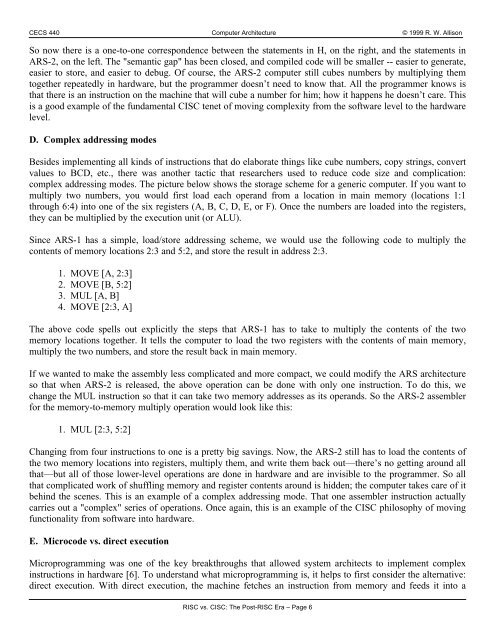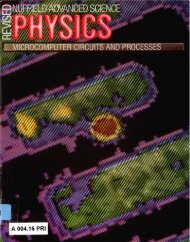RISC vs. CISC
RISC vs. CISC
RISC vs. CISC
Create successful ePaper yourself
Turn your PDF publications into a flip-book with our unique Google optimized e-Paper software.
CECS 440 Computer Architecture © 1999 R. W. Allison<br />
So now there is a one-to-one correspondence between the statements in H, on the right, and the statements in<br />
ARS-2, on the left. The "semantic gap" has been closed, and compiled code will be smaller -- easier to generate,<br />
easier to store, and easier to debug. Of course, the ARS-2 computer still cubes numbers by multiplying them<br />
together repeatedly in hardware, but the programmer doesn’t need to know that. All the programmer knows is<br />
that there is an instruction on the machine that will cube a number for him; how it happens he doesn’t care. This<br />
is a good example of the fundamental <strong>CISC</strong> tenet of moving complexity from the software level to the hardware<br />
level.<br />
D. Complex addressing modes<br />
Besides implementing all kinds of instructions that do elaborate things like cube numbers, copy strings, convert<br />
values to BCD, etc., there was another tactic that researchers used to reduce code size and complication:<br />
complex addressing modes. The picture below shows the storage scheme for a generic computer. If you want to<br />
multiply two numbers, you would first load each operand from a location in main memory (locations 1:1<br />
through 6:4) into one of the six registers (A, B, C, D, E, or F). Once the numbers are loaded into the registers,<br />
they can be multiplied by the execution unit (or ALU).<br />
Since ARS-1 has a simple, load/store addressing scheme, we would use the following code to multiply the<br />
contents of memory locations 2:3 and 5:2, and store the result in address 2:3.<br />
1. MOVE [A, 2:3]<br />
2. MOVE [B, 5:2]<br />
3. MUL [A, B]<br />
4. MOVE [2:3, A]<br />
The above code spells out explicitly the steps that ARS-1 has to take to multiply the contents of the two<br />
memory locations together. It tells the computer to load the two registers with the contents of main memory,<br />
multiply the two numbers, and store the result back in main memory.<br />
If we wanted to make the assembly less complicated and more compact, we could modify the ARS architecture<br />
so that when ARS-2 is released, the above operation can be done with only one instruction. To do this, we<br />
change the MUL instruction so that it can take two memory addresses as its operands. So the ARS-2 assembler<br />
for the memory-to-memory multiply operation would look like this:<br />
1. MUL [2:3, 5:2]<br />
Changing from four instructions to one is a pretty big savings. Now, the ARS-2 still has to load the contents of<br />
the two memory locations into registers, multiply them, and write them back out—there’s no getting around all<br />
that—but all of those lower-level operations are done in hardware and are invisible to the programmer. So all<br />
that complicated work of shuffling memory and register contents around is hidden; the computer takes care of it<br />
behind the scenes. This is an example of a complex addressing mode. That one assembler instruction actually<br />
carries out a "complex" series of operations. Once again, this is an example of the <strong>CISC</strong> philosophy of moving<br />
functionality from software into hardware.<br />
E. Microcode <strong>vs</strong>. direct execution<br />
Microprogramming was one of the key breakthroughs that allowed system architects to implement complex<br />
instructions in hardware [6]. To understand what microprogramming is, it helps to first consider the alternative:<br />
direct execution. With direct execution, the machine fetches an instruction from memory and feeds it into a<br />
<strong>RISC</strong> <strong>vs</strong>. <strong>CISC</strong>: The Post-<strong>RISC</strong> Era – Page 6











